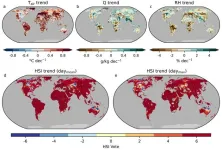Governments, medical institutions and other bodies require accurate models on health-related matters in order to better organize their activities. Climate change has measurable impacts on society, including on human mortality. However, current models to assess the health impacts of climate change do not account for every environmental parameter, especially humidity, which could influence heat stress perceived by the human body, leaving room for improvement. For the first time, researchers, including those from the University of Tokyo, successfully incorporated humidity data from hundreds of cities into so-called heat stress indicators (HSIs) and assessed their performances in predicting heat-related deaths.
Climate change used to be called global warming for good reason: Broadly, temperatures the world over are rising. However, there are other concerns beyond just air temperature; one of these which is incredibly important in some parts of the world is humidity, the amount of water in the air. It’s important as humidity can affect our ability to cool ourselves down through sweating, when water evaporates from our skin. In high humidity environments, this evaporative cooling is less effective and after a point, it becomes impossible.
“I’d been investigating the effect of irrigation around urban areas on heat stress, and how it is related to human health,” said research fellow Qiang Guo from the University of Tokyo’s Department of Global Health Policy. “Depending on what HSIs you looked at, the results and implications appeared quite different. This discrepancy pushed my team and me to look for the best combination of temperature and humidity which would most accurately estimate human-perceived heat stress. And we wanted to make sure this method would apply to different environments.”
Guo and his team gathered daily human death and climate data, which included air temperature, relative humidity, wind speed and incident solar radiation, for 739 cities in 43 countries or territories. They calculated eight different HSIs based on the climate data. Most HSIs use air temperature and humidity as inputs, while others also include wind speed and solar radiation. By using sophisticated models called distributed lag nonlinear models and machine learning, the team found the key factor responsible for the performances of HSIs in different locations is the relationship between daily temperature and humidity.
“The effectiveness of HSIs incorporating humidity varies according to geography. We detected locations where humid heat is a more accurate predictor to model heat-related deaths, including coastal and large lake areas of the U.S., Peru, South Korea and Japan. Utilizing HSIs in these regions, such as wet bulb globe temperature, which mimics how humans feel heat, could improve accuracy of heat-health alert systems,” said Guo. “Of course, there are many other factors to consider: for example, socioeconomic issues. Due to data availability, our study mainly focused on the developed regions, and many developing regions under severe heat stress are not included in our analysis. Because of this, in the future we plan to collect additional data and conduct analyses for regions in the Global South. Our goal is to better assist people in developing economies in reducing the health impacts of severe heat stress.”
###
Journal article: Qiang Guo, Malcolm N. Mistry, Antonio Gasparrini, Masahiro Hashizume, Taikan Oki et al. “Regional Variation in the Role of Humidity on City-level Heat-Related Mortality”, PNAS Nexus, https://doi.org/10.1093/pnasnexus/pgae290
Funding: Q.G., M.H., and T.O. were supported by the Environment Research and Technology Development Fund (JPMEERF23S21120) of the Environmental Restoration and Conservation Agency provided by the Ministry of the Environment of Japan. Q.G. was supported by the Musha Shugyo international travel grants from the School of Engineering, The University of Tokyo. T.O. was supported by the Japan Society for the Promotion of Science (KAKENHI), Grant Number 21H05002, and the Environment Research and Technology Development Fund of the Environmental Restoration and Conservation Agency of Japan (JPMEERF23S21100). M.N.M. was supported by the European Commission (H2020-MSCA-IF-2020) under REA grant agreement no. 101022870. A.G. was supported by the Medical Research Council-UK (Grant ID: MR/V034162/1) and European Union’s Horizon 2020 Project Exhaustion (Grant ID: 820655). J.K. was supported by the Czech Science Foundation, project 23-06749S. AMVC acknowledges funding from the Swiss National Science Foundation (TMSGI3_211626). V.H. acknowledges funding from the European Union’s Horizon 2020 research and innovation program (H2020-MSCA-IF-2020, Grant No.: 101032087). Y.S. was supported by Brain Pool Plus program funded by the Ministry of Science and ICT through the National Research Foundation of Korea (NRF-2021H1D3A2A03097768), and the National Research Foundation of Korea (NRF) grant funded by the Korean government (MSIT) (NRF-2023R1A2C1004754). The authors would like to thank ECMWF that implementing the Copernicus Climate Change Service (C3S) on behalf of the European Union, and developing and publishing the ERA5 data. The authors would like to thank the developer and contributor of elevation (EarthEnv), and Distance to the Nearest Coast (NASA's Ocean Biology Processing Group) datasets.
Graduate School of Medicine - https://www.m.u-tokyo.ac.jp/english/
Graduate School of Engineering - https://www.t.u-tokyo.ac.jp/en/soe
Institute of Industrial Science - https://www.iis.u-tokyo.ac.jp/en/
Global Hydrology Group – https://hydro.iis.u-tokyo.ac.jp/index_en.html
Department of Global Health Policy - https://www.ghp.m.u-tokyo.ac.jp/
Qiang Guo - https://hydro.iis.u-tokyo.ac.jp/~qiang/
Research contact:
Qiang Guo
Department of Global Health Policy, The University of Tokyo,
7-3-1 Hongo, Bunkyo-ku, Tokyo, 113-8656, Japan
qiangguo@m.u-tokyo.ac.jp
Press contact:
Mr. Rohan Mehra
Public Relations Group, The University of Tokyo,
7-3-1 Hongo, Bunkyo-ku, Tokyo, 113-8656, Japan
press-releases.adm@gs.mail.u-tokyo.ac.jp
About The University of Tokyo:
The University of Tokyo is Japan's leading university and one of the world's top research universities. The vast research output of some 6,000 researchers is published in the world's top journals across the arts and sciences. Our vibrant student body of around 15,000 undergraduate and 15,000 graduate students includes over 4,000 international students. Find out more at www.u-tokyo.ac.jp/en/ or follow us on X (formerly Twitter) at @UTokyo_News_en.
END




